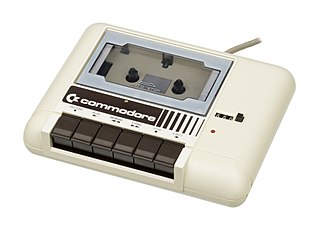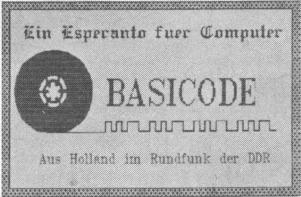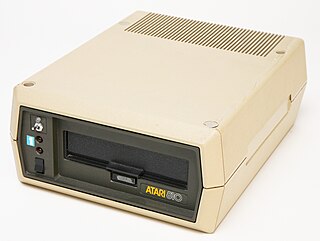
Peripheral Component Interconnect (PCI) is a local computer bus for attaching hardware devices in a computer and is part of the PCI Local Bus standard. The PCI bus supports the functions found on a processor bus but in a standardized format that is independent of any given processor's native bus. Devices connected to the PCI bus appear to a bus master to be connected directly to its own bus and are assigned addresses in the processor's address space. It is a parallel bus, synchronous to a single bus clock. Attached devices can take either the form of an integrated circuit fitted onto the motherboard or an expansion card that fits into a slot. The PCI Local Bus was first implemented in IBM PC compatibles, where it displaced the combination of several slow Industry Standard Architecture (ISA) slots and one fast VESA Local Bus (VLB) slot as the bus configuration. It has subsequently been adopted for other computer types. Typical PCI cards used in PCs include: network cards, sound cards, modems, extra ports such as Universal Serial Bus (USB) or serial, TV tuner cards and hard disk drive host adapters. PCI video cards replaced ISA and VLB cards until rising bandwidth needs outgrew the abilities of PCI. The preferred interface for video cards then became Accelerated Graphics Port (AGP), a superset of PCI, before giving way to PCI Express.

Small Computer System Interface is a set of standards for physically connecting and transferring data between computers and peripheral devices, best known for its use with storage devices such as hard disk drives. SCSI was introduced in the 1980s and has seen widespread use on servers and high-end workstations, with new SCSI standards being published as recently as SAS-4 in 2017.

The Atari 8-bit computers, formally launched as the Atari Home Computer System, are a series of 8-bit home computers introduced by Atari, Inc. in 1979 with the Atari 400 and Atari 800. It is the first home computer architecture with coprocessors, enabling more advanced graphics and sound than most of its contemporaries. Video games are key to its software library, and the 1980 first-person space combat simulator Star Raiders is considered the platform's killer app.

I2C (Inter-Integrated Circuit; pronounced as “eye-squared-see” or “eye-two-see”), alternatively known as I2C or IIC, is a synchronous, multi-controller/multi-target (historically-termed as master/slave), single-ended, serial communication bus invented in 1982 by Philips Semiconductors. It is widely used for attaching lower-speed peripheral ICs to processors and microcontrollers in short-distance, intra-board communication.

Atari BASIC is an interpreter for the BASIC programming language that shipped with Atari 8-bit computers. Unlike most American BASICs of the home computer era, Atari BASIC is not a derivative of Microsoft BASIC and differs in significant ways. It includes keywords for Atari-specific features and lacks support for string arrays.

In telecommunication and data transmission, serial communication is the process of sending data one bit at a time, sequentially, over a communication channel or computer bus. This is in contrast to parallel communication, where several bits are sent as a whole, on a link with several parallel channels.

The SAM Coupé is an 8-bit British home computer manufactured by Miles Gordon Technology (MGT), based in Swansea in the United Kingdom and released in December 1989.

The TI-99/4 and TI-99/4A are home computers released by Texas Instruments in 1979 and 1981, respectively. The TI-99 series competed against home computers such as the Apple II, TRS-80, Atari 400/800, and VIC-20.
Serial Peripheral Interface (SPI) is a de facto standard for synchronous serial communication, used primarily in embedded systems for short-distance wired communication between integrated circuits.

The Commodore 1530 (C2N) Datasette, later also Datassette, is Commodore's dedicated magnetic-tape data storage device. Using compact cassettes as the storage medium, it provides inexpensive storage to Commodore's 8-bit computers, including the PET, VIC-20, and Commodore 64. A physically similar model, Commodore 1531, was made for the Commodore 16 and Plus/4 series computers.

POKEY, an acronym for Pot Keyboard Integrated Circuit, is a digital I/O chip designed by Doug Neubauer at Atari, Inc. for the Atari 8-bit computers. It was first released with the Atari 400 and Atari 800 in 1979 and is included in all later models and the Atari 5200 console. POKEY combines functions for reading paddle controllers (potentiometers) and computer keyboards as well as sound generation and a source for pseudorandom numbers. It produces four voices of distinctive square wave audio, either as clear tones or modified with distortion settings. Neubauer also developed the Atari 8-bit killer application Star Raiders which makes use of POKEY features.

The Television Interface Adaptor (TIA) is the custom computer chip, along with a variant of the MOS Technology 6502 constituting the heart of the 1977 Atari Video Computer System game console. The TIA generates the screen display, sound effects, and reads the controllers. At the time the Atari VCS was designed, even small amounts of RAM were expensive. The chip was designed around not having a frame buffer, instead requiring detailed programming to create even a simple display.
In computing, channel I/O is a high-performance input/output (I/O) architecture that is implemented in various forms on a number of computer architectures, especially on mainframe computers. In the past, channels were generally implemented with custom devices, variously named channel, I/O processor, I/O controller, I/O synchronizer, or DMA controller.

The PS/2 port is a 6-pin mini-DIN connector used for connecting keyboards and mice to a PC compatible computer system. Its name comes from the IBM Personal System/2 series of personal computers, with which it was introduced in 1987. The PS/2 mouse connector generally replaced the older DE-9 RS-232 "serial mouse" connector, while the PS/2 keyboard connector replaced the larger 5-pin/180° DIN connector used in the IBM PC/AT design. The PS/2 keyboard port is electrically and logically identical to the IBM AT keyboard port, differing only in the type of electrical connector used. The PS/2 platform introduced a second port with the same design as the keyboard port for use to connect a mouse; thus the PS/2-style keyboard and mouse interfaces are electrically similar and employ the same communication protocol. However, unlike the otherwise similar Apple Desktop Bus connector used by Apple, a given system's keyboard and mouse port may not be interchangeable since the two devices use different sets of commands and the device drivers generally are hard-coded to communicate with each device at the address of the port that is conventionally assigned to that device.

BASICODE was a computer project intended to create a unified standard for the BASIC programming language. BASIC was available on many popular home computers, but there were countless variants that were mostly incompatible with each other. The project was initiated in 1980 by Hobbyscoop, a radio program of the Dutch broadcasting organisation Nederlandse Omroep Stichting (NOS).
Atari 8-bit computer peripherals include floppy drives, printers, modems, and video game controllers for Atari 8-bit computers, which includes the 400/800, XL, XE, and XEGS.

The Atari 810 is the official floppy disk drive for the Atari 400 and 800, the first two models of Atari 8-bit computers. It was released by Atari, Inc. in 1980.

The Atari Program Recorder is Atari's dedicated magnetic-tape data storage device for the Atari 8-bit computers. The original 410 was launched along with the Atari 400 and 800 machines in 1979. The 1010 was a smaller model introduced to match the styling of the XL series released in 1983. XC12 of 1986 matched the XE series and was sold mostly in eastern Europe and South America. Slight variations of all of these models were also introduced from time to time.

The Atari joystick port is a computer port used to connect various gaming controllers to game console and home computer systems in the 1970s to the 1990s. It was originally introduced on the Atari 2600 in 1977 and then used on the Atari 400 and 800 in 1979. It went cross-platform with the VIC-20 in 1981, and was then used on many following machines from both companies, as well as a growing list of 3rd party machines like the MSX platform and various Sega consoles.



















